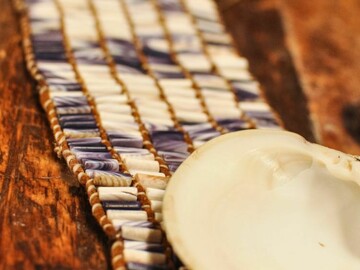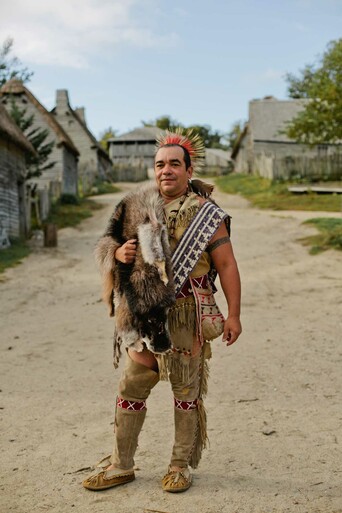Wampum Belt
- Date
- 2016
- Material
- Acrylic Beads, Sinew, Deerskin
- Author/Maker
- Robert Charlebois (Sokoki Nation, Odanak First Nation Quebec)
- Source
- Plimoth Patuxet Museums

Description
The most well-known type of decorative Native belt used in southern New England was the wampum belt. Wampum refers to the white and purple beads made from the shell of the hard clam (known as a quahog). Elizabeth James-Perry is an Aquinnah Wampanoag artist who makes and works regularly with wampum. She asserts:
“the shell is considered wholesome because the material comes out of the Atlantic ocean, from which Wampanoag continue to derive sustenance and identity.“ 1
Historically, creating a single bead - tedious and time consuming even with modern tools - was a considerable effort. White beads were more common than those made of the deep purple color fond only at the hinge and edge of the quohog shell, making these beads highly prized. Traditionally, belts of wampum beads served as a type of written language in the Haudenosaunee and Algonkian tribes including the Wampanoag, in ceremony, as adornment, and as a medium of trade. Wampum belts were often worn by tribal leaders and designed to illustrate tribal stories and considered symbols of wealth and status. The patterns of the white and purple beads told of important community events and values, and they serve to pass stories on to future generations. Assonet Wampanoag historian, Nanepashamet, wrote:
One wampum belt is mentioned in Plymouth Colony sources as eaily as 1623. Ousemequn (Massasoit) attended the wedding of William Bradford and Alice Southworth in August of that year, and Emmanuel Altham sent a description of the sachem’s clothing to his brother in England: ‘about the breadth of a span [approximately nine inches] he wears beads about his middle. And these beads they make themselves, which they account as gold above silver before the beads we bring out of England. 2 The wampum belt and the black wolf skin that Ousamequin wore on his shoulder were insignias of his position as a sachem. [Fifty years later, Metacom] was seen in Boston, on an important state visit, wearing a broad belt of wampum either over his shoulder or around his waist. After [Metacom’s] death in August 1676, Captain Benjamin Church was given Metacom’s regalia as a spoil of war. In Church’s chronicle of the conflict now known as King Philip’s War, he reports that Anawon (whom colonial writers described as Metacom’s principal captain) “pulled out [Metacom’s] be;lt being curiously wrought with wampum, being nine inches broad, wrough with blak and white wampum, in various figures and flowers, and picture of many birds and beasts.”3
No one knows if Metacom’s wampum belt still exists. Their disappearance is one of American history’s great mysteries. If any could be found, their recovery and return to the Wampanoag homeland would have the same cultural impact as the return of the Bradford manuscript to Massachusetts in 1897. According to Mashpee Wampanoag historian and cultural leader, Paula Peters:
“this type of belt, which was a community belt, it would have been something that people in the community contributed to generation after generation… it was like a historic document to us, a living document, and it told our story for generations.” 4
Plymouth’s Governor Josiah Winslow sent the belts to King Charles II in 1677 with letters announcing the end of King Philip’s War in southern New England. They never arrived. Winslow had trusted his brother in law with the delivery. The few surviving letters between the English crown and the Plymouth governor do not shed light on the vanished belts.
Media

Pokanoket sachem, Ousamequin - also known to history as Massasoit - is represented here by Darius Coombs (Mashpee Wampanoag). His regalia is based on an eye-witness description of Ousamequin's arrival at William Bradford's wedding to Alice Southworth in summer 1623.

Discussion Questions
- What is wampum? How was it used by Wampanoag and other Indigenous people?
-
What role(s) did wampum play historically in Wampanoag diplomacy and community building?
-
How was wampum used as a symbol of colonial victory in King Philip’s War in 1676?
- Why is wampum important to Wampanoag people today?
Footnotes
- 1 Elizabeth James Perry, “About Wampum” Elizabeth James-Perry Aquinnah Wampanoag Artist. Accessed 5/1/23.
- 2 Emmanual Altham to Sir Edward Altham, September 1623 from Three Visitors to Early Plymouth: Letters about the Pilgrim Settlement in New England During It’s First Seven Years by John Pory, Emmanual Altham, and Isaak de Rasieres ed. Sydney V. James, Jr. (Plimoth Plantation, 1963) pg.29
- 3 “Clothing and Ornament of the Native
- 4 Logan Perley, “350 years of searching: Wampanoag still looking for historic wampum belt,” Unreserved - Candian Broadcasting Company. Accessed 5/1/23